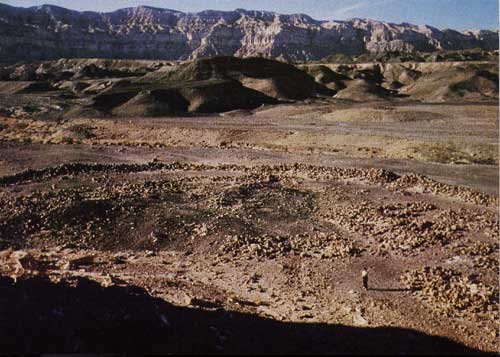The Timna Valley is situated in the southern Arabah, circa 30 kilometres north of Eilat. The valley is extremely rich in copper ore, which has attracted people to this place from antiquity (ever since the late Neolithic period, circa 5,000 BC). Prof. Beno Rothenberg had extensively and very skillfully explored the mining and copper smelting complexes at Timna for many years. As the archaeological work progressed it became apparent that in addition to the metallurgical enterprises the Timna valley boasts of additional remains that tell the story of the daily life as well as the cult and art of the people inhabiting the region. Most prominent among these are a few large rock drawings dated to the end of the Late Bronze Age (ca. 1,300 BC), on which the current project focuses.
Recently the park authorities have noticed that the situation of some of the rock art at Timna deteriorates rapidly. As a result they have initiated the TRACE project - Timna Rock Art Conservation Exploration.
 |
Ramesside smelting camp at Timna (:from Rothenberg B., Timna: Valley of the Biblical copper mines, 1972) |
TRACE’s goals are:
-
To establish a baseline for the known rock art at the Timna valley as it is today.
-
To identify the causes for the apparent deterioration in the rock art situation and to understand these processes’ mechanisms.
-
To offer conservation solutions.
-
To perform the required steps for the rock art conservation.
-
To monitor future changes.
The project was officially opened on 4 April 2005, with a ceremony attended by the major supporter of TRACE, the Ambassador of the United States to Israel, Mr Dan Kurtzer, and the director of the Israel Antiquities Authority, Mr Shuka Dorfman.
A brainstorm meeting with the participation of a large group of researchers of different disciplines and institutions (from Israel, the USA and Germany), followed the opening ceremony.The meeting was devoted to establishing the guidelines for the implementation of TRACE. Two persons were appointed to coordinate the project: Yuval Yekutieli (Ben-Gurion University of the Negev) will deal with the research and academic part, and Michael Lavi (Timna Park director) will direct the operational component of the project.
TRACE is extremely willing to cooperate with colleagues from the other side of the valley who face the same problems. Interested colleagues might contact Yuval Yekutieli directly (yuvaly@bgu.ac.il).
Yuval Yekutieli